Chapter Three
WHAT ARE THE PLANETS?
In the same way that man has his experience in many different "houses," so he has many ways of acting or different "skills," with which to meet the needs of experience. These are indicated in a horoscope by the planets.
The planets are the bodies that move against the background of fixed stars in the heavens. They form the patterns, by their position in the houses and signs, through which the horoscope has its correspondence to human affairs. Ten are commonly used by astrologers. Mars, Jupiter, Saturn, Uranus, Neptune and Pluto have paths of motion in the sky farther from the sun than the earth's own orbit, and in that order. Venus and Mercury have their paths between the earth and sun. The moon, which circles the earth directly and closely, is an important "planet" astrologically. The sun, which has an apparent motion, due to the fact that all these heavenly movements are observed or measured from the earth, is the tenth and most vital "planet" of all.
The ten bodies are placed in the horoscope exactly as they lie in the heavens, and as they are seen from the earth-center point of view, but they are indicated by symbols which the beginner now must learn. Except in the case of the recently discovered Uranus, Neptune and Pluto, these symbols are combinations of three basic elements. First is the circle, which represents spirit or the limitless "source" of life. Second is the cross, which by contrast stands for simple matter or lifeless substance. Third is the crescent or half circle which is the linking of spirit to life through experience, and is the development of a personal sensitiveness or "feeling" which in astrology becomes a representation of "soul."
The easiest way to learn the meaning of the planets is to look at specially selected horoscopes in which each planet in turn is brought to special prominence. In such a case the life of an actual person will illustrate the planet's significance far better than any description in words. The beginner has mastered the houses in preliminary but thorough fashion through the "hemisphere emphasis" in outstanding example charts. Now he can be helped by a reverse hemisphere emphasis, or by cases where only one out of all the planets is east, west, south or north. This situation is known as "singleton."
The location of a lone planet in a hemisphere gives it an exaggerated influence, on the principle that anything set off by itself has special importance. At times a singleton planet will seem to dominate all the other nine together. The native's whole character will be given a pointed emphasis in the affairs of the singleton's hemisphere. This makes it possible to observe the particular genius of any given planet by taking the case of some well-known person where it is a singleton.
Mars
The symbol of Mars is the cross of matter placed over the circle of spirit, and in practice the cross is made like an arrow-head. This indicates a way of acting in which practical things are more important than ideal ones. It describes activity in its most tangible form. The position of Mars in the horoscope reveals the pattern of initiative, or shows how the native ordinarily will start anything.
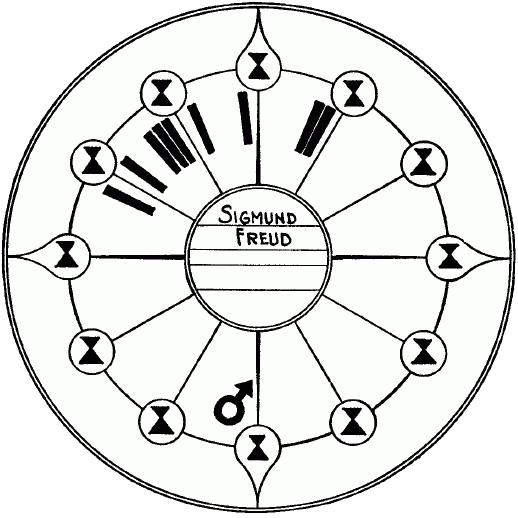
The example chart is Sigmund Freud. His northern hemisphere is given basic importance by a singleton Mars. The fact that Mars is his most important planet makes him a pioneer, and the fact that his northern hemisphere is emphasized means that, like Martin Luther, his work is concerned with the inner side of life. As a matter of record, no other man in human history has done as spectacular a job of pioneering in the hidden depths of personality. Thus he gives an excellent dramatization of this planet's fundamental nature.
Moreover, the beginner may note in passing that Mars lies in the third house. This house rules ordinary environment, and shows that Freud's pioneer work has to take place in the affairs of everyday living. What he started was a technique for adjusting every individual to the normal situations around him.
Jupiter
The symbol of Jupiter is the cross of matter supporting the crescent of soul on its left or east arm. This indicates a way of acting in which the individual selects the circumstances of his self-expression, or in which the soul acts "eastwardly" by its spontaneous and often "jovial" participation in life. The position of Jupiter in the horoscope reveals the pattern of enthusiasm, or shows how the native ordinarily will invite experience or expand his relationships.
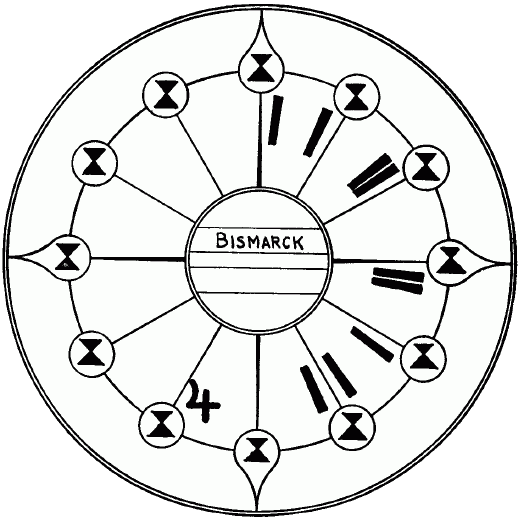
The example chart is Bismarck, one of the astute statesmen of the nineteenth century. The fact that Jupiter is a singleton makes this native particularly sensitive to responsibility. The fact that his eastern hemisphere is emphasized means that, like the resourceful lady, he is the executor of his own opportunity. Moreover, the place of Jupiter in the third house means that, like Freud, he works with potentialities immediately at hand. His life dramatically reveals Jupiter's fundamental power of organization, or capacity for enlisting the fullest cooperation of others.
Singleton Near the Hemisphere Line
The beginner will note that the singleton is not directly vertical to the hemisphere containing the other planets, and that this makes no difference in its operation. He should wonder, however, how this case differs from that of Woodrow Wilson, where a planet was eight degrees across the line. In contrast with the former case, Bismarck's Jupiter is in a different sign from the hemisphere line, almost a full thirty degrees into the singleton hemisphere; the distinction is effective because it is sharp.
Saturn
The symbol of Saturn is the cross of matter placed over the crescent of soul, and in practice both the cross and crescent are somewhat modified. This indicates a way of acting in which the individual accepts experience, or in which the soul definitely adjusts itself to practical facts. The position of Saturn in the horoscope reveals the pattern of this sensitiveness, or shows how the native ordinarily will develop any depth of understanding.
The example chart is Havelock Ellis, whose work was important in bringing human biological differences into a true psychological perspective. The fact that Saturn is a singleton makes him particularly sensitive to the deeper significance of experience, as well as more than usually aware of common or superficial inhibitions. The fact that his western hemisphere is emphasized means that, like Woodrow Wilson, he is not only a product of circumstances largely beyond his control, but is also denied any real sense of achievement during his own lifetime. Moreover, the place of Saturn in his sixth house indicates his life-work with the maladjustments and sickness of mankind. His life, in terms of its sensitiveness, its depth and its withdrawal from transient and unimportant activities, gives a remarkable insight into Saturn's nature.
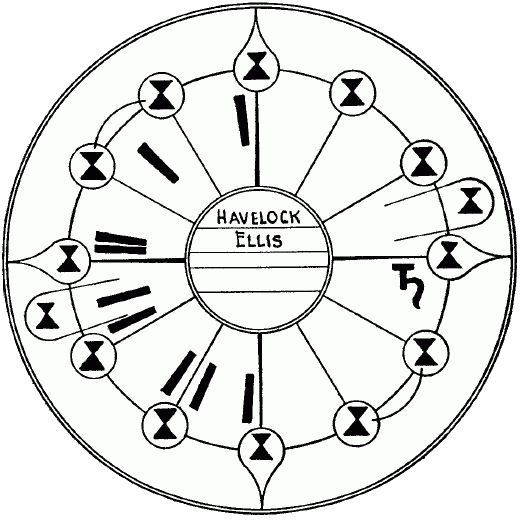
Uranus
The symbol of Uranus had its origin in the initial letter of Herschel, the planet's discoverer, and is often explained as this "H" with a planet suspended from the cross-bar. The three planets that were not known until modern times, although they can be calculated for the horoscopes of any prior period, are primarily a part of the modern experience that led to their discovery, and so are most useful in their indication of the characteristic affairs and relations of modern civilization. As the first of the new planets, Uranus indicates a way of acting with special social initiative. This is the originality which a widespread civilization makes possible. Thus the position of Uranus in the horoscope reveals the pattern of independence in the life, or shows how the native ordinarily will keep himself free from dictation.
The example chart is Shakespeare, perhaps the world's greatest interpreter of human nature. The fact that Uranus is a singleton makes him exceptionally detached from the people and conditions around him, and the fact that the planet was not discovered until nearly two centuries after his death is reflected by the different conception of his work in his own age and in present times. The fact that his northern hemisphere is emphasized means that, like Luther and Freud, he reveals a special understanding of the hidden side of life to the modern or Uranus-conscious world, although in his own day he lived wholly objectively under a southern "hemisphere emphasis," and so produced his own plays very "commercially." The place of Uranus in the fourth house means that his most vital concern is with the true roots or "home nature" of men generally, however unsuspectingly this may have been on his own part.
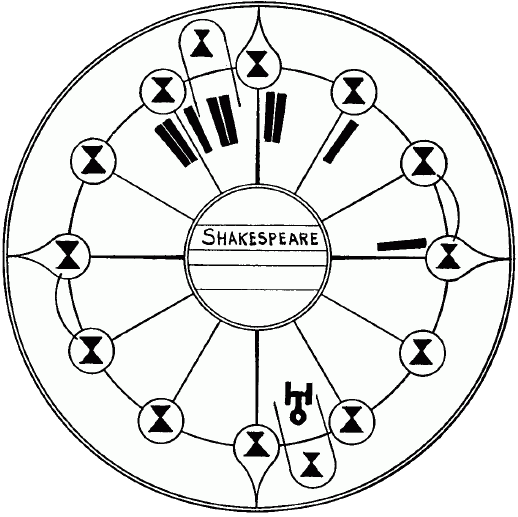
The beginner may note that the uncertainty concerning the details of Shakespeare's birth and life is of dramatic interest here. In other words, the extent to which this horoscope "fits" Shakespeare's life is an important illustration of the fact that any tradition about a man, in order to survive at all, must have as reasonable an astrological basis as any actual history. Here is an almost spectacular revelation of the planet's power to cut across all the lines of lesser or trivial realities.
Neptune
The symbol of Neptune is the trident or three-pronged fishing spear which was long the special emblem of the god from whom the name was taken. Neptune's discovery followed the discovery of Uranus, and its meaning must follow the significance of Uranus, and be derived from the modern experience to which both correspond. After originality, always, come the consequences of the original action, and this is social responsibility. Neptune indicates a way of acting by which the individual fits himself into the civilized mode of life in which he realizes his freedom. This is bondage, when it is not understood, otherwise it is willing conformity to the needs of the group. The position of Neptune in the horoscope reveals the pattern of social obligation, or shows how the native ordinarily will conform to the general desire of his fellows.
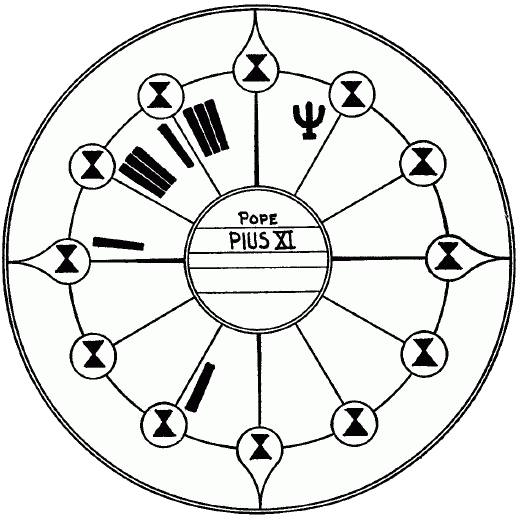
The example chart is Pius XI, the most important of modern rulers in the Roman church, and an excellent case because his birth followed the discovery of the planet within a decade. The fact that Neptune is a singleton endows him with a high sense of social responsibility, and makes it possible for him to carry out the great new orientation in Catholicism as this was specially symbolized by the establishment of Vatican State. The fact that his western hemisphere is emphasized means that, like Woodrow Wilson and Havelock Ellis, he works with events largely beyond his control. Thus, despite his achievements, he was weighted down to the end by his inability to contribute effectively to world peace. The place of Neptune in his ninth house means that his most vital concern is with understanding and religious values. His marked fidelity to these is a striking illustration of Neptune's dynamic sense of obligation.
Pluto
The symbols for Pluto are many, ranging from a modified "PI" and the character for Mars with an extra stroke to the circle of spirit placed in a chalice of experience. This latter symbol is an adaptation of an old alchemical idea, to suggest that the planet has a refining function in human affairs. The four commonly used of these symbols are shown in the example chart. As the third and most recently discovered planet, Pluto indicates a way of acting in response to the latest social "trends," or describes the individual's cooperation with the widening possibilities in civilized society. The position of Pluto in the horoscope reveals the pattern of impressionability, sensitiveness to group moods, or shows how the native ordinarily will rationalize his own relations to society at large.
The example chart is Sir William Rowan Hamilton, a mathematician and astronomer of wide and original brilliance. The fact that Pluto is a singleton makes it possible for him to deal with the pure ideas or theoretical relations with which modern science is most concerned. The fact that both his south and east hemispheres are emphasized means that he is enabled not only to establish his achievement solidly in an objective world, but also to be the entire director of his own accomplishment. Moreover, the place of Pluto in his eleventh house means that his vital concern is with objectives, giving him an exceptional direction of his effort to definite ends.
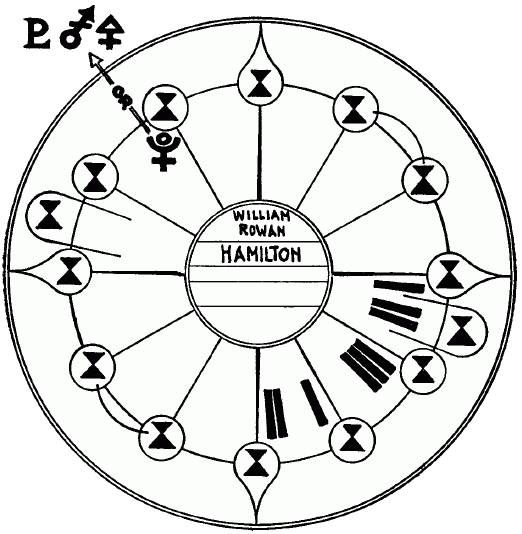
The fact that Pluto was not located until 1930 limits the examples of achievement among those born since its discovery, but in Sir William's chart the singleton Pluto is a genuine indication of the scientific anticipations which characterized his life, and of his power for reasoning in a complete detachment from every immediate situation of his own time, because all this takes on its real meaning and perspective after Pluto's discovery. Here is an excellent revelation of the planet's actual nature, as it is more normally evident in present-day scientific investigation.
Venus
The symbol of Venus is the circle of spirit placed on top of the cross of matter. This indicates a way of acting in which ideal things are more important than practical ones. It describes action in the terms of its contribution to values. This may be relaxation and satisfaction on the one hand, or repudiation and ultimate distaste on the other. The position of Venus in the horoscope reveals the pattern of simple pleasure and appreciation in the life, or shows how the native ordinarily will finish things, and give them meaning.
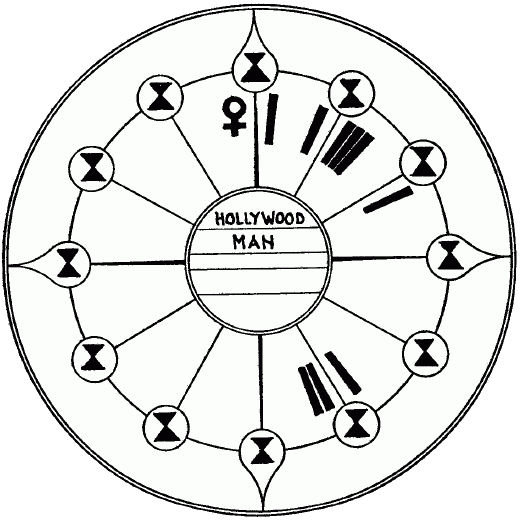
The example chart is a Hollywood man of prominence, typical of those individuals whose esthetic development particularly dramatizes the nature of Venus. The fact that this planet is a singleton reveals him as extremely impatient with outworn or commonplace ties, and passionately devoted to pleasure or the experience of the beautiful in every phase of intimate human relationship. The fact that his eastern hemisphere is emphasized means that, like the resourceful lady, Bismarck and Sir William Hamilton, he is the actual architect and administrator of his own destiny. Moreover, the place of Venus in his tenth house means that he is able to capitalize handsomely upon his esthetic talents in the motion picture field, affording a neat and sharp illustration of this planet's nature.
Because the two planets inside the earth's path in the solar system, Venus and Mercury, have relatively small orbits, they cannot get very far away from the sun, and the sun is always closely associated with them in consequence. This means that singleton cases for any of these three bodies are not only rare but unsatisfactory, since they may usually be taken equally well or even more naturally as simple hemisphere-emphasis. The Venus example just employed is an excellent case of the planet's influence, but it should be obvious even to an inexperienced astrologer that the picture of an esthetic control of the life, under this eastern hemisphere singleton, is matched by an equally valid conception of a man held to a table d'hôte limitation of experience, in any ordinary everyday sense, by his very overbalanced interest in esthetic things. This latter view of his career is held by his family, who have no sympathy at all with any of the ideals expressed in the Venus singleton. Here again the young astrologer may see how all the proper "looks" at a horoscope will be reconciled and confirmed in the single unified fact of the actual life.
The Moon
The symbol of the moon is the simple crescent of soul, and this is significant because there is neither modification of the symbol nor suggestion of limitation upon the soul. The moon indicates a way of acting in a wholly unashamed self-interest. It describes the inner rehearsal of experience by the soul, and also the resulting wholly individual activity through which the native remains a distinct personality among his fellows. The position of the moon in a horoscope reveals the pattern of the soul's inner response, usually called the "feelings" in sharp distinction from the sensitiveness of understanding under Saturn, or shows how the native ordinarily will establish himself in everyday affairs through his emotional, common and public characteristics.
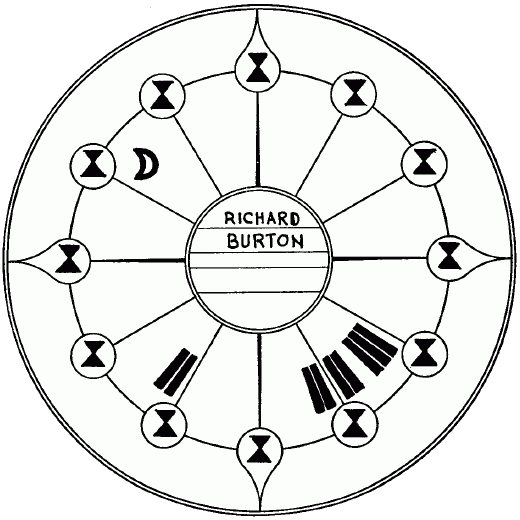
The example chart is Sir Richard Burton, famous translator of the Arabian Nights, as well as noted adventurer in India and the Near East. The fact that the moon is a singleton gives him the gift for a complete emotional placing of himself in any chosen reality. Thus it was possible for him to disguise himself and make the pilgrimage to Mecca in days when discovery as an intruder was sure death. The fact that his southern hemisphere is emphasized means that, like Queen Victoria and Sir William Hamilton, he is utterly undisturbed by inner complications, and is able to direct the whole of his energies to a given task of the moment. Moreover, the place of the moon in his eleventh house means that, like Sir William again, his vital concern is with objectives, or the definite direction of his efforts to tangible ends. The degree to which he was so strikingly a "personage" is excellent dramatization of the moon's fundamental character.
In passing, the beginner may note that Pius XI has a north singleton planet as well as his west singleton Neptune. This is the moon, and it shows the spiritual kinship between the pope and Martin Luther in the north, as well as between the pope and Burton in the emotional completeness with which they could give themselves to whatever enterprise engaged them, under the moon singleton. The Neptune emphasis in the case of Pius has been more valuable for illustrative purpose, but the moon singleton is more sharply defined, and would be of greater primary value in any personal delineation of that native's life.
The Two Remaining Planets
The meaning of the sun and Mercury, which remain, is approached more effectively by different techniques, in each case, than the singleton charts. Their symbols, however, can be analyzed in the same fashion as the others.
The Sun
The symbol of the sun is the circle of spirit with a dot or "period" in the middle. This indicates a way of acting in which spirit, as the central "self" or will, is made evident in experience. The position of the sun in the horoscope reveals the pattern of the will, or shows how the native ordinarily will seek to strengthen his own personal integrity.
Mercury
The symbol of Mercury is the crescent of soul placed in the form of a cup on the circle of spirit, which in turn has been placed on the cross of matter. This indicates a way of acting in which the supremacy of idea over material things is made personal. It describes the continuing use made of the things finished or given meaning under Venus, which most simply is the awareness and ordering of various factors in experience, or basic mentality. The position of Mercury in the horoscope reveals the pattern of "mind," in an important distinction from the driving determination of "will," or shows how the native ordinarily will know the circumstances of his situation.
Mercury's Function
The fact that Mercury and the sun must always remain close to each other in the skies is the real basis of Mercury's function in astrology, and this suggests the technique by which the beginner may gain an effective idea of the planet's nature. The sun is the central body of these two, exactly as the "will" is central in man. Mercury, by contrast, is continually changing its relationship. Now it presses ahead of the sun, and now it falls behind. Man's "mind" in the same way is now ahead of his situation or affairs, and now behind. The working of the "mind" is much like the activity of a youngster out walking with his father. There are times when he runs ahead to investigate this or that, only to drop back for support or encouragement, and other times when he lags behind in a moment of concern over some fascinating aspect of things, until it is necessary to hurry forward and catch up again.
The only important difference between one mind and another is the underlying or general tendency of one individual to reach forward and anticipate things, and of another to lean back and recapitulate them, together with the further distinction by which some minds do this in rather an extreme degree, whereas others remain relatively close to the central balance of will. Mercury in this fashion indicates four types of "mentality." The identification of these types, among the twelve example cases with which the beginner has been concerned, will give him an excellent conception of the planet's function in astrological delineation.
The older astrologers distinguished Mercury's position on the basis of its clockwise "rising" ahead of the sun, rather than its counterclockwise "moving" ahead of the sun. In other words, when Mercury is a morning star it is "ahead," and when it is an evening star it is "behind." This form of expression is too well set in practice to be changed.
If Mercury is "ahead" of the sun in this respect, that is, swinging away from it in a clockwise direction, the native's mind is "eager." If it is more than fourteen degrees ahead—that is, more than half its possible distance—the mind is not only eager, but is also untrammeled. Then the mind is like the little boy when he is far enough ahead of his father to feel altogether free to examine everything, and to deal with everything, quite in his own imperious way. Queen Victoria, of the four cases in the first chapter, is the example of this. Her life was not only wholly objective, but she was able to see everything objectively in her mind, and to make her decisions and guide her own movements without interference from any inner reaction or feeling. She was exceptionally alert to her responsibilities as queen, and was interested in their full detail with an almost child-like ingenuousness. In the eight charts of the third chapter, those of Bismarck, Havelock Ellis and Shakespeare all indicate this untrammeled eagerness of mind. They also were able to approach life with a real mental objectivity, easily evident in the work of Bismarck and Shakespeare but no less marked in the scientific clarity and wit of Ellis.
When Mercury rises ahead of the sun in the natal chart by less than fourteen degrees, the mind is eager but is more will-censored or self-conscious. This is illustrated, in the four original examples, by Martin Luther, but by no one at all in the eight following cases. Luther pushed on ahead of his fellows in his spiritual battle, but he no less leaned back almost desperately for support in the tradition of the church. This confirms the north hemisphere emphasis of his chart, as in contrast with the southern placing of the planets in the queen's horoscope. Luther wanted to reform the evil ways of the church, but he had no desire to start a new organization, or to plunge forward into any unknown depths.
When Mercury rises behind the sun, swinging away from it in a counterclockwise direction by more than fourteen degrees, the mind is "deliberate" rather than eager, and in the extreme of this separation is also "untrammeled." The resourceful lady is an example of this "mental chemistry." Her thinking, like that of Queen Victoria's, is without self-sensitiveness. This is a characteristic which is reinforced in her case by the eastern hemisphere-emphasis. At the same time her mind is deliberate, or careful. She took good account of lessons from the past, and gave attention to the general store of human wisdom. Differing from the queen, she anticipated nothing but instead viewed life in a continual recapitulation. To her, the more it changed the more it was the same thing. Her mentality is like that of William Rowan Hamilton, whose case is the one parallel among the eight charts used to introduce the planets. Sir William, despite his work a full century ahead of his time, saw the future of knowledge as only a clarification or refinement of materials already possessed in one aspect or another.
The fourth type of "mental chemistry" is the deliberate mind which is self-conscious, indicated when Mercury rises behind the sun by less than fourteen degrees. Woodrow Wilson is the example of this, with his ever-evident historical background, or his personal sensitiveness to the lessons of history. Because no problem arose in his focal dealing with others at the seventh house, he uncritically felt himself to be the very agent of history itself. This form of mental make-up is found also in four out of the eight charts in the present chapter. Thus Sigmund Freud is as essentially personal, dealing with the very roots of self, as Havelock Ellis is scientifically objective, possessing an untrammeled and eager mind. Richard Burton, second of the four cases in question, was self-consciously concerned with the cultural roots of man to an extent which led him into real notoriety, and the Hollywood man buried himself in the deep stirrings of human relations to no less exaggerated a degree, equally against his own interests. Pope Pius XI assimilated his whole personality into the actual body of the church, and almost sought to live its whole history in his own exceptionally sensitive ideals and efforts.
By the time the beginner has been given further example horoscopes, he will be equipped with the simple factors he will need to determine this Mercury-sun relation for himself in any chart. The form in which these earlier examples are presented, except the introductory complete wheel, has given no identification to the planets generally, and no indication at all of the distances separating them. The details of technique would be useless and confusing at this point.
The special consideration of the sun is best approached in a separate chapter, but the whole scheme of the planets is complete, and the beginner will do well to make sure he has mastered the materials thus far given before he proceeds to the next step in understanding.
THE PLANETS AND THEIR SIMPLE MEANING
Arranged in an order of practical convenience
Moon Feeling
Mars Initiative
Venus Acquisitiveness
Mercury Mentality
Jupiter Enthusiasm
Saturn Sensitiveness
Uranus Independence
Neptune Obligation
Pluto Obsession
Summary
In summary, what has the beginner learned in this third chapter? He has found out that if any hemisphere in a horoscope, created at the east, west, north or south, contains a single planet only, known as a singleton, this planet will reveal a dominant way of acting in the native's life. By looking at example charts of singleton emphasis for each of the planets in turn, excepting only Mercury and the sun, he has achieved a preliminary but real idea of their meaning. At the same time he has been introduced to the symbols for all ten of these bodies, together with the implications of the symbolism in each particular case.
He has gained an insight into the nature of Mercury by observing the difference, in the twelve example cases, between those whose Mercury rises ahead of the sun and those whose Mercury rises behind. In each of these two classes he has observed the further distinction between those whose Mercury is relatively distant from the sun and those whose Mercury is close.
He has had further experience in looking at actual horoscopes, and in coming to definite and correct conclusions by the use of the few simple facts he has acquired so far in his study. This should give him an increasing confidence in his own capacity. The example charts have afforded him an additional drill in the meaning of hemisphere emphasis, and in the significance of six out of the twelve houses. He has seen, although to a very limited degree, how exceptions to exact rule are in themselves an indication of importance.

Home | About | Blue Letters | Marc Edmund Jones | Greetings from Members | MEJ Books | Contact
Copyright © 1973-2014. All rights reserved.